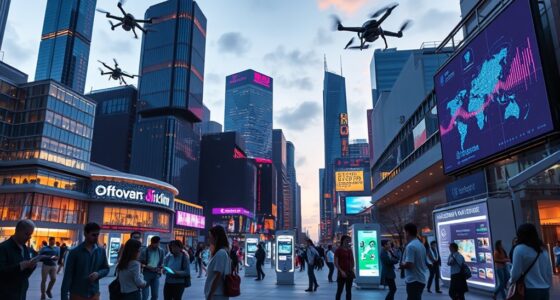AI-driven inequality widens the gap between regions because advanced economies adopt new technologies faster, boosting productivity and growth. Meanwhile, emerging markets lag behind, struggling with lower AI integration, which limits job opportunities and widens income gaps. Social and demographic factors like education, gender, and age further influence how AI affects different groups. If you want to understand how these disparities develop and what it means for global progress, there’s more to explore.
Key Takeaways
- Advanced economies adopt AI faster, boosting productivity and widening regional economic gaps.
- Emerging regions face limited AI integration, resulting in slower growth and persistent disparities.
- AI benefits mainly high-skilled workers, deepening social inequalities within and across regions.
- Offshoring and automation disproportionately impact low-skilled jobs in less developed areas.
- Demographic factors like gender and education influence AI exposure, reinforcing existing social hierarchies.

Are AI advancements widening the gap between different regions and social groups? It’s a question you should be asking yourself as you observe global economic shifts. In many parts of the world, particularly in emerging economies, the adoption and integration of AI remain limited. For example, only about 10% of jobs in the EAP region involve AI-complementary tasks, a stark contrast to the 30% seen in more advanced economies. This disparity isn’t just about the number of jobs but also about the quality and productivity gains that come with AI. Northern European countries, for instance, experience higher AI exposure in similar occupations compared to Eastern Europe, highlighting that even within continents, regional differences persist. These disparities often stem from choices in technology adoption—where advanced economies leverage industrial robotization and AI-driven productivity, many developing regions lag behind, unable to benefit equally. This leads to regional inequalities, with wealthier nations reaping more gains while others struggle to keep pace. Advanced economies tend to adopt new technologies more rapidly and effectively, which accentuates the gap in economic outcomes.
You’ll also notice that these gaps aren’t solely geographic but occupational. Certain jobs, like business professionals, are more exposed to AI, with exposure rates reaching nearly 87%, while physical roles such as cleaners see exposure below 33%. Curiously, similar patterns emerge across countries—Finland and Lithuania, for example, display comparable profiles of occupational AI impact, regardless of their regional contexts. This indicates that AI’s influence cuts across borders, yet the benefits are unevenly distributed. Workers in high-skilled, office-based roles capitalize more on AI, widening the skill gap and leaving low-skilled workers more vulnerable. The same trend manifests in manufacturing, where automation has displaced many low-skilled workers in ASEAN nations, even as robots increased skilled employment slightly.
Demographic factors intensify these inequalities further. Women in the EAP region, though less exposed overall, face more AI impacts than men, and better-educated workers encounter greater exposure than their less-educated counterparts. This stratification widens existing skill gaps, making social mobility more difficult. Young workers, especially Gen Z, report that AI devalues traditional education pathways, limiting opportunities for those entering the workforce. Meanwhile, offshoring white-collar jobs to cost-effective markets like India fuels global wage compression, further marginalizing workers who can’t compete with cheaper labor sources. All these factors contribute to a widening divide—regions and groups that embrace AI early and effectively benefit more, while others are left behind, deepening the global inequality landscape.
Frequently Asked Questions
How Does AI Impact Rural Versus Urban Development?
You see that AI impacts rural and urban development differently. In cities, AI boosts productivity, automation, and planning, but rural areas struggle with data shortages and limited AI adoption. This leads to widening gaps in healthcare, workforce opportunities, and infrastructure. While urban regions benefit from advanced AI tools, rural communities face barriers like resource constraints, risking further economic divergence and slower development.
What Policies Can Mitigate Ai-Driven Regional Disparities?
You can bridge regional gaps by investing in infrastructure, expanding broadband, and creating local tech hubs, empowering both rural and urban areas. Launch tailored reskilling programs, implement broad AI literacy campaigns, and foster university-business partnerships to prepare your workforce. Promote inclusive AI development, support local solutions, and guarantee equitable investment distribution. These policies help you reduce disparities, foster growth, and ensure everyone benefits from technological progress.
Are There Historical Precedents for Technology-Induced Inequality?
Looking at the current question, history shows that technological change often increases inequality, but policy interventions can help. For example, during the Industrial Revolution, wealth concentrated among capital owners, but governments eventually implemented education and social programs to reduce disparities. Similarly, in ancient societies, state-provided public goods and regulations helped manage inequality. These precedents suggest that with deliberate political choices, you can influence how technology impacts economic fairness.
How Can Underrepresented Communities Benefit From AI?
You can benefit from AI by gaining access to personalized healthcare, education, and financial services that address systemic barriers. AI helps bridge gaps in healthcare, reducing disparities and improving life expectancy for underserved communities. It also offers tailored learning programs and financial tools that foster economic mobility. By actively engaging with these technologies, you can improve your opportunities, enhance skills, and promote equitable growth within your community.
What Role Do International Organizations Play in Addressing AI Inequality?
Did you know that international organizations have allocated over $1 billion to develop global AI infrastructure? They play a vital role by creating policy frameworks, promoting open innovation, and fostering partnerships. You can rely on them to set standards, guarantee ethical development, and reduce disparities. Their efforts help bridge the digital divide, making AI benefits accessible worldwide, especially in underserved regions, by coordinating resources and encouraging inclusive growth.
Conclusion
So, as you stand on this digital frontier, remember that AI’s tide can lift some regions while leaving others stranded, much like the Industrial Revolution’s uneven spread. If you don’t champion equitable policies, you risk deepening the divide, turning today’s Silicon Valley into a gilded cage. Just like knights of old guarding their treasures, you must guarantee AI benefits everyone, not just the privileged few, or future generations might look back at this era as the dawn of an unbridgeable chasm.









